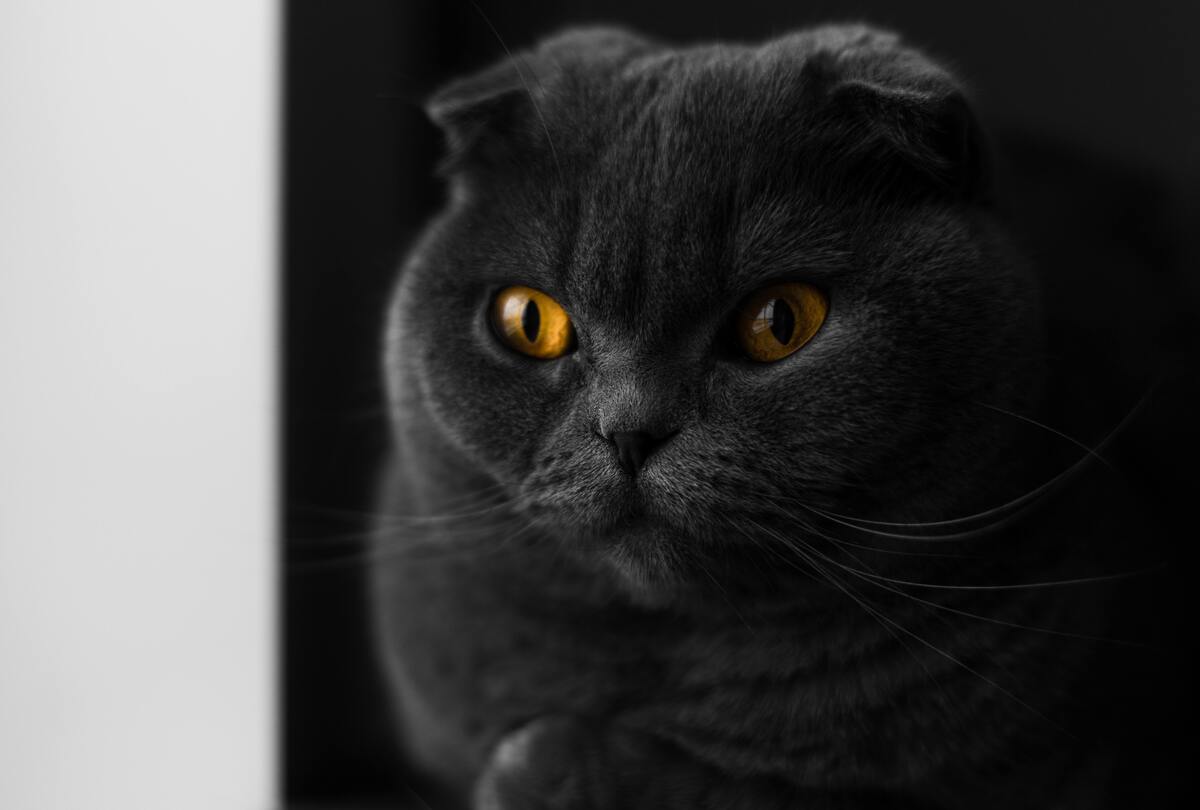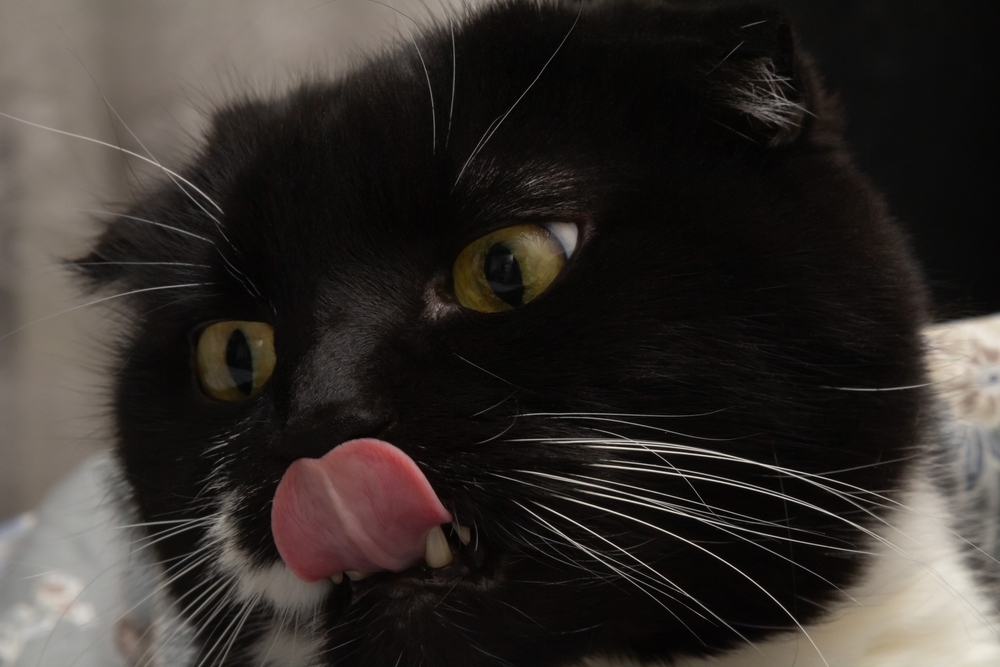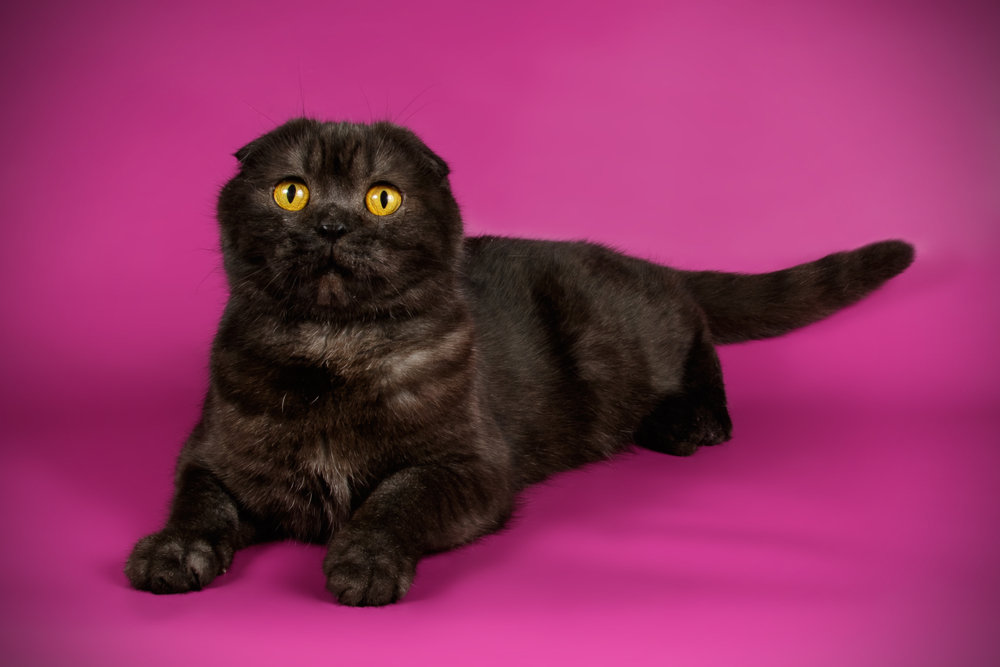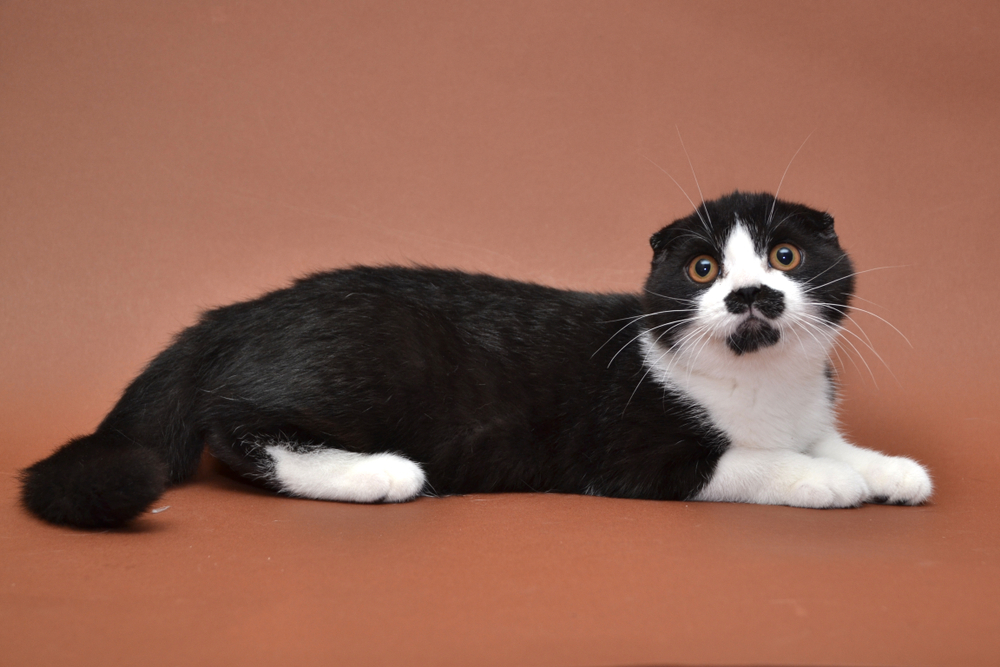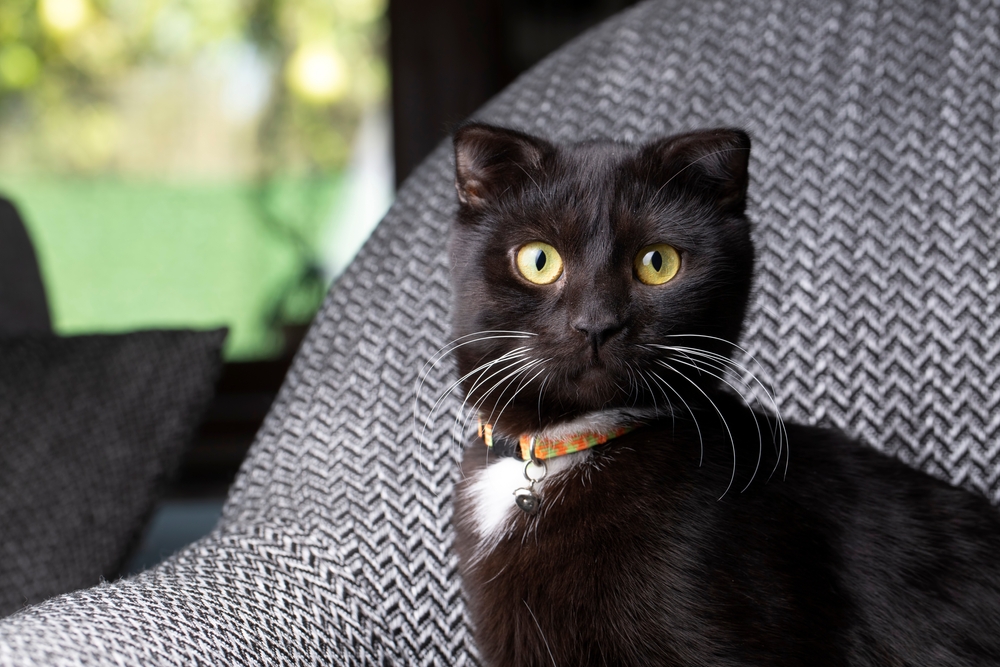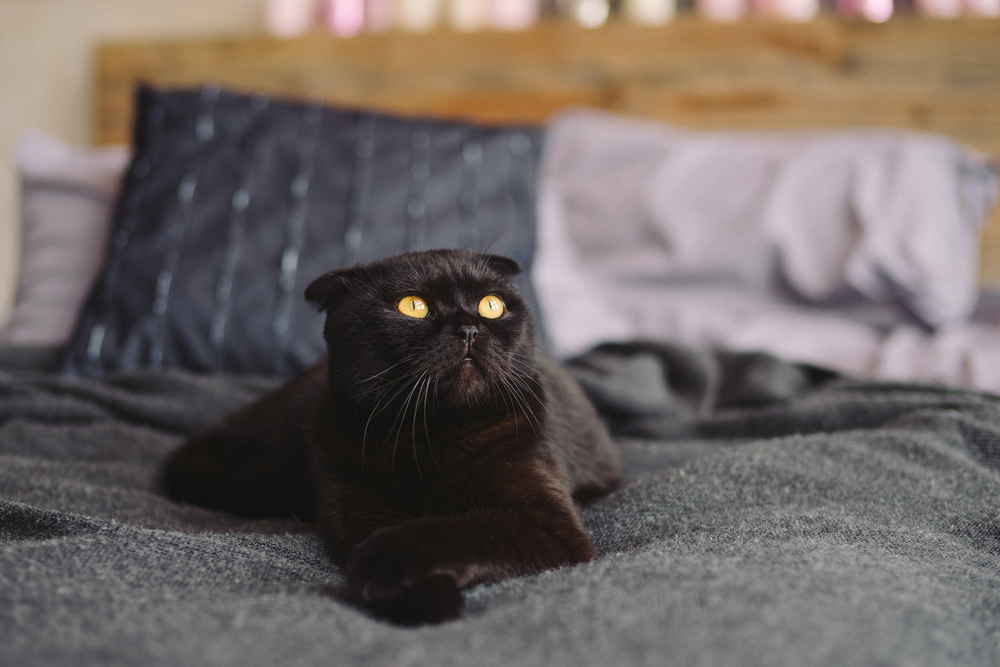📖 Table of Content:
Scottish fold cats are the cutest creatures you’ve ever seen, there’s no question about that. With famous folded ears, round faces, and big round eyes, they’re the greatest way to get a teddy bear that can meow, purr, and eat more than you. What about a black Scottish fold, though?
Because of the signature owl-like appearance, Scottish fold cats are sought-after and adored by millions and millions around the world. Blue, cream, and white Scottish folds are the only ones that attract attention – black Scottish folds are mysterious moggies that turn heads and raise questions.
Black cats are associated with witchcraft, Halloween, and the worst myths known to man, but they’re much more than that. Black Scottish folds are affectionate, appreciative cats that thrive on hanging out with humans and make for the purrfect pets. With that out of the way, read more down below!
What’s there to know about the Scottish fold breed?
Scottish fold cats are a rare breed. With tight, forward-facing folded ears, round heads, and even rounder eyes, Scottish folds are what dreams are made of.
Whether you’re on the market for a low-maintenance breed that adores hanging out with humans or an eye-catching breed that begs to be pet, you came knocking on the right door.
We’d go as far as to agree that Scottish fold cats are what would happen on the off chance that an owl and a cat had a baby. Now, that would be a great get-to-know-my-cat-better story, but that’s not how these bad boys came to be.
Everything started with a kitten named Susie born on a rural Scottish farm in the early 1960s. Even though Susie’s parents were average farm cats, Susie was born with a genetic mutation that gave her strange, surprisingly folded ears.
Susie became the star of the farm and breeders flocked to Susie’s farm to breed her with American shorthair and British shorthair cats. So, Susie became the foundation of a brand new breed. Nowadays, Scottish fold cats are adored by millions because they’re simple, sweet, and easy-going.
Scottish folds are the embodiment of loyalty. Whether they’re waiting for you to come back from work to shower you with snuggles or napping on your chest soothed by your rhythmic breathing, they’re guaranteed to become the best pet you’ve ever owned.
With everything they’ve been through to get here, Scottish folds deserve your undivided attention. What about black Scottish folds, though? What’s the tea with them?
What’s a black Scottish fold?
Scottish fold cats, with all color combinations and patterns, took the world by storm right away.
When we’re referring to the formal recognition of the breed by reputable organizations, though, we do need to mention that these bubbly beauties struggled to stay in the spotlight due to the genetic mutations we mentioned beforehand.
With a little help from a breeder William Ross and geneticist Pat Turner, Scottish fold cats managed to get the attention and acceptance they deserved from the get-go. The Cat Fanciers’ Association (CFA) recognized the Scottish fold in 1973 and the International Cat Association (TICA) followed suit in 1979.
We do need to mention that different types of the Scottish fold were recognized at different times. Black Scottish folds, with black or black smoke coats and white undercoats, famous folded ears, and gorgeous golden eyes, were accepted by both CFA and TICA around the same time.
Because of their cute appearance and sweet temperament, black Scottish folds are one of the most popular and prominent breeds out there. Scottish folds are Taylor Swift-approved and we’re more than happy to help you uncover and understand why. We’ve prepared a few of our favorite facts down below!
8 fantastic facts about the black Scottish fold guaranteed to make you want one right away
1. Scottish fold cats come from an ancestor by the name of Susie
We mentioned beforehand that Scottish folds can be traced back to a farm cat by the name of Susie. But we couldn’t pass on the opportunity to rave about that one more time.
Susie marked the beginning of a brand new breed without even knowing what she was doing. Before you dare utter something along the lines of “What’s so special about Susie,” remember that there aren’t that many breeds that start as a consequence of a genetic mutation.
Breeding Scottish folds with American and British shorthairs might have kickstarted the process of establishing the breed, but Susie was the one who started the entire thing on her own. We salute you, Susie!
2. Black Scottish fold kittens are born with straight ears that become folded over time
Susie was born with flat, folded ears, but her kittens donned pretty, perked-up ones for the first few weeks. Susie wasn’t bothered by that, but the breeders and geneticists trying to create the new breed were more than happy to see her kittens’ ears going down after days and days of monitoring.
What happened? Well, Scottish fold kittens are born with straight ears that become flatter within the following 18 to 24 days – but only if they have the gene that is responsible for the fold. With the responsible gene missing, the kittens’ ears remain straight.
When that happens, though, the kittens aren’t Scottish fold but rather Scottish shorthair. About 50% of the litter with one Scottish fold parent ends up with flat, folded ears.
3. The famous folds are a consequence of a genetic mutation
What would Scottish folds be without the famous folded ears?
Black Scottish folds are the most mysterious black cats out there, but we wouldn’t bank on the fact they’d be as admired and approved without the famous folds. However, the folds are actually the reason why these bad boys struggled to get accepted by the CFA and TICA.
According to these two associations, the folds are the result of a spontaneous genetic mutation that affects the development of cartilage in the Scottish fold’s ears.
Because of the mutation, Scottish fold cats are susceptible to severe health problems such as osteochondrodysplasia, arthritis, and cardiomyopathy. At the end of the day, getting your black Scottish fold from a reputable breeder could decrease the risk. That’s something to keep an eye on, for sure.
4. There are three types of folds
When you’re on the hunt for a black Scottish fold, you might want to pay attention to the degree of folds the one you want comes with. With three types to choose from, you’ve got your work cut out for you. What are the three types, you wonder?
Single, double, and triple folds refer to the degree of how folded a Scottish fold’s ears can get.
Single folds refer to the slight fold occurring at the tip of the ear. Double folds, on the other hand, come with a more prominent bend, with the upper half of the ear bending downward. Triple folds, of course, refer to the complete fold, with the ears sitting flat against the head making the head appear rounder.
5. Scottish fold cats are the only folded-ear cats that can compete
Scottish folds, black or otherwise, are the most established breed with folds. What does that mean? While there are other breeds with folded ears, Scottish folds are the only ones allowed to compete.
According to the Cat’s Fanciers’ Association, Scottish lineage cats with folded ears are permitted in the show ring. Additionally, Scottish fold cats with triple folds are the only ones deemed to have show quality.
6. Scottish fold cats are never bred together
Scottish fold cats are almost always bred with American shorthair or British shorthair cats. Because of that, the kittens’ aren’t always born with flat folds and aren’t considered a member of the Scottish fold breed. However, there’s a good reason why Scottish fold cats are never bred together.
Breeding two Scottish folds can cause the kittens to be born with degenerative problems. Now, the breeders don’t know whether that would happen every time two Scottish folds are bred together. But because of ethical concerns, that’s not something they’re willing to experiment with.
7. Black Scottish fold cats are super sensitive
When we argue that these are the most affectionate, appreciative cats, we’re not kidding. Black Scottish folds are the cutest, cuddliest cats you’ve ever had the pleasure of snuggling with. But, but, but – there’s always a but when we’re talking about handling Scottish folds.
With a fragile, frail frame, we do need to mention that these curious creatures require gentle handling. Whatever you do, remember to pick your Scottish fold up with caution and pet her with soft, subdued pressure.
8. Black Scottish fold cats almost always come with golden eyes
Oh, these round-faced sweethearts are much more than folded ears and owl-like features.
We can’t finish the article without mentioning the fact that black Scottish cats almost always come with golden eyes. We’d argue that these beauties didn’t need another feature to make them more attractive, but alas – we’re more than happy to swoon over them.
Whatever you decide to do, know that a black Scottish fold would complete your life in more ways than one!
